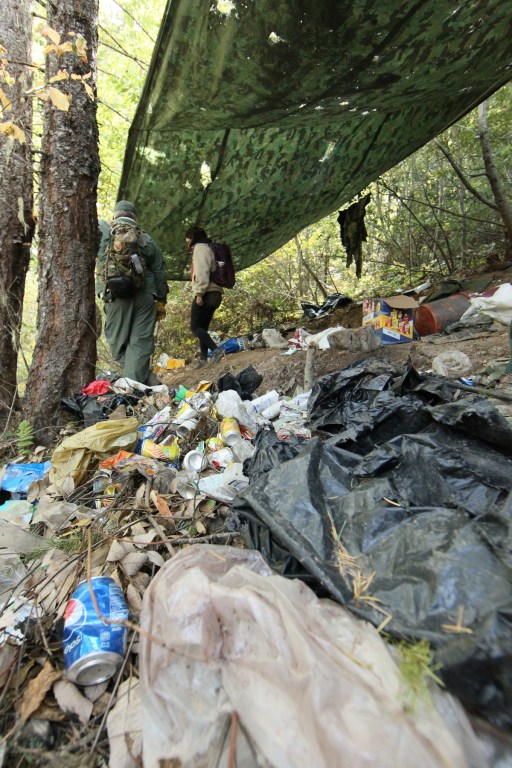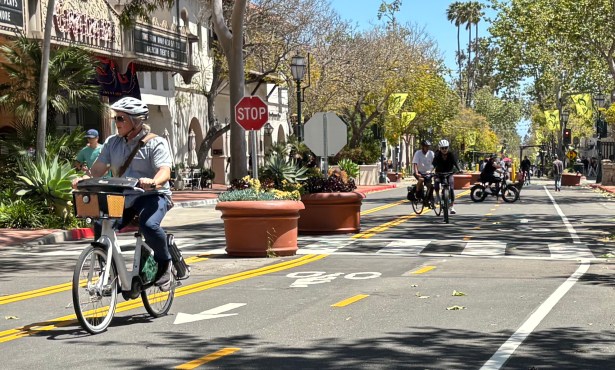Trash from Cannabis Trespass Grows
Illegal Cannabis Farming Harms the Central Coast
Despite the legalization of marijuana in California, drug trafficking cartels continue to trespass on national forests and other public lands to illegally grow cannabis for the illicit market.
While most of these operations have been in Northern California, their presence and destruction is increasing on the Central Coast, including in remote areas of Los Padres National Forest.
These operations rip out plants and trees and use deadly pesticides and fertilizers that infiltrate soil, waterways, and food webs on which sensitive wildlife depend. This is particularly harmful in the backcountry of Los Padres National Forest, where the last remnants of the region’s intact native habitat host endangered plants and animals that are already threatened by climate change.

Last year, more than 74,000 plants were seized in trespass grows in the Padres along with more than 80 firearms. The Ventura County Sheriff’s office stated that there was a significant increase in the amount of marijuana grown illegally in the national forest compared to previous years. Police have also found human trafficking and other illegal drug production at trespass operations.
In recent years, trespass operations have caused or been associated with major fires.
Last year’s Dolan Fire near Big Sur burned 125,000 acres, destroyed 14 homes, and led to a mudslide that wiped away a section of Highway 1. The fire killed 11 endangered condors, and the mudslides buried and killed thousands of rare black abalone in coastal waters.
Reports have indicated that the Dolan Fire was intentionally started by drug traffickers trying to detract attention from their operations in the Los Padres National Forest.
Over the past decade trespass grows have been associated with 13 fires that have burned over 285,000 acres in California. Three of those fires have been on the Central Coast.
Trespass operations can also impede firefighting efforts. According to Cal Fire reports, firefighters have been confronted by armed growers as well as booby traps and explosive ammunition.
Officials have found illegal and deadly pesticides in trespass grows including carbofuran, which can impair the nervous system and cause tremor, convulsions, and even coma. Carbofuran’s combustibility makes it even more dangerous during a wildfire, where it could be inhaled by firefighters and nearby residents.
Although many states have legalized cannabis, the illegal market continues to thrive across most of the nation, keeping trespass grows lucrative.
Los Padres ForestWatch receives regular reports from residents living along the national forest boundaries about growers trespassing private property to reach and cultivate remote areas. Yet at present, state and federal agencies are woefully understaffed to prevent or even clean up after trespass operations.
Los Padres National Forest, which spans 1.75 million acres from Monterey County to Ventura County, has only seven people tasked with patrolling trespass operations. This equates to one officer being responsible for 250,000 acres, an area larger than the entire city of San Diego.
And over the past year, during a pandemic, as more Americans discovered outdoor recreation and explored their local public lands for the first time, officials are reporting that trespass grows have also been increasing, causing additional safety concerns.
If we are going to protect California’s public backcountry from trespass grows, the federal government must increase its prevention and reclamation efforts.
Fortunately, members of Congress, including Representative Salud Carbajal, are working in partnership with the Cannabis Removal on Public Lands Project to increase investment in enforcement and clean-up efforts.
With more Californians in the backcountry than ever before, and trespass grows steadily increasing, bold and swift action is needed to protect our land, water, and environment.Rebecca August is Director of Advocacy for Los Padres ForestWatch. Richard McIntyre is Executive Director of the Cannabis Removal on Public Lands Project.




You must be logged in to post a comment.